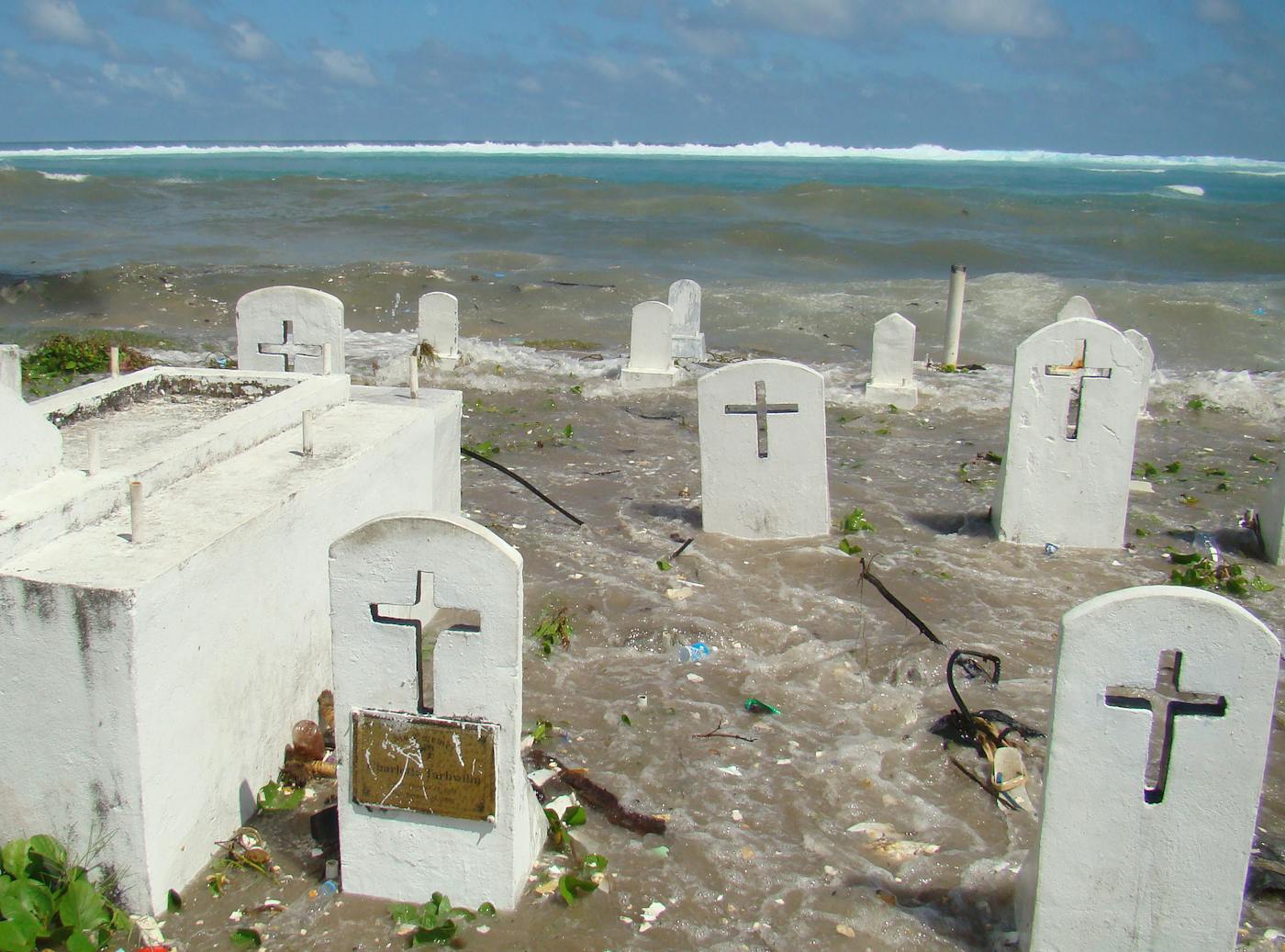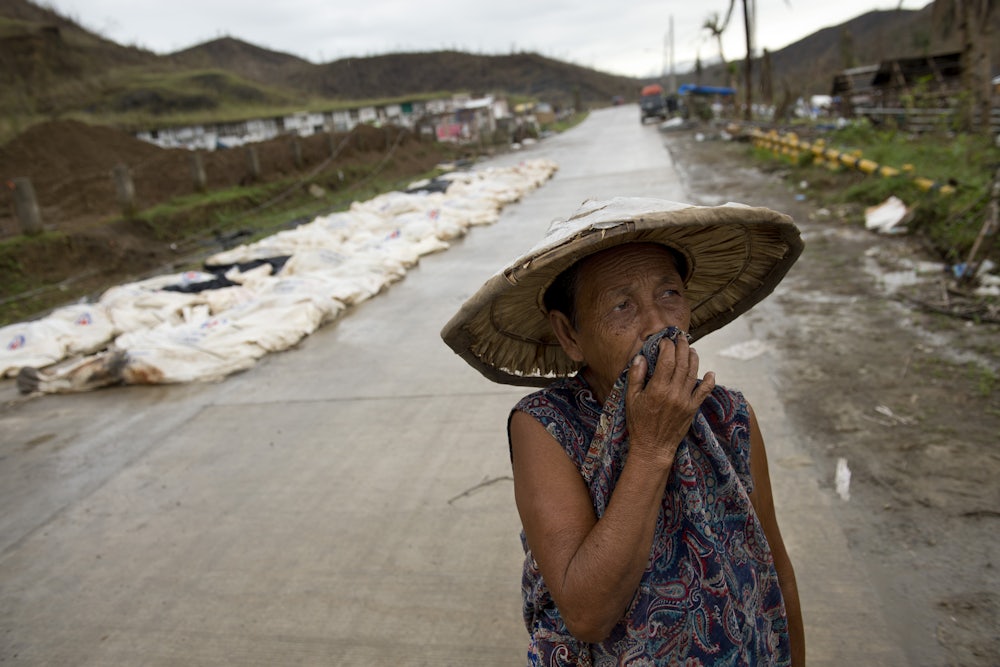Alberta holds one of the world’s most ravaged regions. In the north of the Canadian province, a vast sprawl of industry the size of Florida has been erected to haul tar sands from beneath the forests, desiccating the land in pursuit of profitable oil, which in turn warms the planet and destroys its ecosystems. The Indigenous peoples who live among these gray wastes have a powerful word to describe what has long been happening to them. “If we don’t have land and we don’t have anywhere to carry out our traditional lifestyle,” George Poitras of the Mikisew Cree First Nation told a journalist in 2007, “we lose who we are as a people. So if there’s no land, then it’s equivalent in our estimation to genocide of a people.” Tony de Brum, the revered former leader of the Marshall Islands—a low-lying Pacific atoll once abused as an American nuclear testing lab, where homes are already being washed away by rising waters—also uses this provocative term. The “displacement of populations and destruction of cultural language and tradition,” he said in 2015, “is equivalent in our minds to genocide.”
Scholars and organizers have long warned that as the planet decays, genocides will become more likely. Infrastructure collapse, resource scarcity, and authority vacuums could, they hypothesize, throw entire peoples from the lands of their birth, forced to battle each other to survive. Some governments will draw down the portcullis or build up the border wall—islands of reaction.
But climate change is not just an imminent threat—something about to happen, hanging portentously like a guillotine blade over the horizon. In fact, it is already here; we live amid its damages. And those threatened Indigenous nations raise an important question: Is it possible that climate change is not just a trigger of genocide but also a genocidal force in and of itself? Could this incendiary form of international law really be used as tool against the biggest polluters and destroyers of our homes?
When we think about genocide today, we think of a particular kind of violence—a singular event of incredible destruction carried out by a set of perpetrators against a definable group, such as the Ottoman Empire’s mass deportation of Armenians, Serbian camps for Bosnian Muslims, Hutu pogroms of Tutsi, and perhaps above all, the Nazi murder of millions of Jews. The techniques of obliteration can be crude and fanatical or high-tech and methodical, but they share three criteria: the targeting of particular and distinct victims—a tribal, ethnic, or religious unit; the deliberate and calculated conspiracy to murder, provable in common criminal court as if only one person had killed another; and, more abstractly, a sense that such violence is unique and discrete, not a normal thing to occur.
By this kind of strict legal understanding, it would be a waste of breath and effort to haul the chiefs of Chevron, Aramco, DuPont, Bayer, Nestlé, Tyson, or any of the largest carbon emitters into the dock at the International Criminal Court and charge them with genocide by climate change. For starters, the multitude of ways our ecology has been altered does not create a uniform method of murder. The planet’s crisis comes from more than just carbon accumulation. Rather, in David Wallace-Wells’s evocative term, it is a “cascade”: a rolling compound of ozone depletion, aerosol loading, freshwater exhaustion, phosphorous- and nitrogen-cycle imbalances, general pollution, and so on. As instruments of slaughter, infernos in California and New South Wales have little in common with floods in Miami and Manila, or heatwaves in Karachi and Kirkuk. And even when these forces are at their most devastating, one might object, there is still no specific ethnic, religious, or tribal group suffering on its own—it appears to afflict all nature and all people, albeit not remotely equally.
Then there’s the issue of intent: Those corporate captains and their political accessories are not strictly speaking conspiring, a defense lawyer might argue, to produce a particular drought or outbreak of disease through their emissions. Their assault on the planet isn’t so finely honed. Each of them has been guilty of other crimes and might have even paid meager penalties for polluting rivers, busting unions, tainting topsoil, commissioning death squads, deforesting whole districts, stirring cancer in local populations, or in earlier times, as with United Fruit or BP or Brown Brothers, ordering the overthrow of governments. One could allege the grossest kind of negligence where global warming is concerned. But is that the same thing as genocide?
The 1948 Convention on the Prevention and Punishment of the Crime of Genocide was the product of messy, reluctant negotiations. Even after the harrowing experience of the Second World War and the trials of Nazi officials at Nuremberg, Britain, the Soviet Union, and the United States had to be harried and badgered into accepting genocide as law. The resulting convention defined genocide as encompassing not just the deliberate killing of members of a “national, ethnical, racial or religious group,” but also actions like causing them “serious bodily or mental harm” or imposing conditions “calculated to bring about its physical destruction in whole or in part.” The Allied powers who reluctantly agreed to this were themselves, by any measure, guilty of that very crime in their recent pasts. Only through the efforts of Rafael Lemkin, a dogged Jewish prosecutor from Poland who coined the term “genocide,” was the Convention established at all. In his lobbying, Lemkin had to gut and neuter his original, more radical proposal. Had his early theory taken hold, calling climate change “genocide” might be much more widespread today.
Lemkin’s conception of genocide had three phases. First, Barbarism, which is what we think of as genocide today: “a coordinated plan of different actions aiming at the destruction of essential foundations of the life of national groups.” Second, and importantly, came Vandalism: the deliberate destruction of culture. In Lemkin’s mind, culture meant art, ritual, literature, language, music, treasure houses of sacred texts. Every people on the planet produced culture, and all of it was equally valuable. As he wrote rather beautifully, “The contribution of any particular collectivity to world culture as a whole forms the wealth of all of humanity.” Vandalism, therefore, was an assault on “world culture.” An injury to one is an injury to all. Lastly came Denial: “the imposition of the national pattern of the oppressor.”

Lemkin understood that these phases supported one another: The crime of genocide could not be committed without each annihilatory act taking place. Just killing people was not genocide, but rather an atrocity or a crime against humanity. What was necessary was the destruction of bodies as well as culture and, ultimately, memory. Genocide was more than a discrete occurrence in geographically restricted space. In Lemkin’s terms, it endangered “the entire social order” and smashed “the very basis of social harmony.”
Lemkin’s understanding of vandalism—the destruction of culture as a formative aspect of genocide—is what the Indigenous leaders describe when they talk about a lost way of life. When culture is intimately connected to place, and natural environment forms a distinct, immutable part of a people’s identity, then environmental destruction is also cultural destruction.
Of course, many of us moved away from an intimate connection with the environment long ago. We don’t therefore experience climate change as a form of genocide in the same way. But in a brutal kind of irony, those least responsible for the rising rate of emissions will be those who shoulder the worst burden. Mainly, it will be the poorest: subsistence farmers and fishermen, precarious wage laborers, slum dwellers, those who cannot grab hold of the lifeboats built by the rich. What is unfolding could be, in a sense, a series of individual “slow genocides” that, taken together, amount to a collective extermination.
Genocide scholarship also offers a way to argue that climate change meets the criteria for criminal intent. In his legal analysis of the Ottoman Empire’s crimes during the First World War, the Australian-British human rights barrister Geoffrey Robertson pointed to an interpretation of English common law used in the successful prosecution of Rwandan genocidaire Jean-Paul Akayesu. This interpretation argues that intent can be inferred from action: The perpetrator, whether by acting or refusing to act, can be considered responsible for a crime if they know what the outcome would be.
Any theory of climate change as a genocidal force would then have to hinge on foreknowledge. What did the frackers and dumpers and drillers and fellers know about the likely outcome of their actions, and when did they know it? An easy date might be June 23, 1988, when James Hansen, a scientist at the National Aeronautics and Space Administration, gave his revelatory testimony to the Senate Energy Committee saying he and his colleagues were 99 percent sure global warming was being caused by emissions. Or perhaps July 1977, when Exxon’s senior scientist warned the company’s management committee about the deathly potential of its product. Other milestones might include the release of any of the Intergovernmental Panel on Climate Change’s six assessment reports. Viewed this way, the emitters’ concerted, conspiratorial campaign of disinformation and denial against the scientific consensus takes on a vastly more sinister and sadistic edge.
Above all, Rafael Lemkin understood genocide as a process, not an event. It had to acquire movement and momentum, only stalling when there were no more bodies to take, no more artifacts to destroy, no more habitats to defile. Our capacity to live, let alone to flourish on this planet, is declining every day. In our time, genocide is no longer a sporadic or lamentable phenomenon but a constant reality: a steady normal.
For two centuries, guilt has accumulated. The conundrum now, as we enter the turbulence of true crisis, is where to place it. Dragging the corporate titans who profited from driving the world to the brink before a judge would only scrape the scummy surface. Complicity runs considerably further—from middle managers and lobbyists to the halls of Congress. The regular way of doing things in the industrialized parts of the globe can no longer continue as valuable or even feasible.
Short of a revolutionary rewriting of the 1948 Genocide Convention on the terms Rafael Lemkin intended, calling climate change “genocide” is little more than scholarly definition and a kind of polemical accusation. Genocide, whether we like it or not, is still an existing legal concept enshrined in statutes with penalties attached—none of which, most likely, could be applied to climate change.
But there remains something alluring about using it all the same. It seems to suggest the possibility of redemption: that those responsible—as with some of the perpetrators in Rwanda or the former Yugoslavia—might have judgment cast upon them by the world’s highest court. Of course, even that wouldn’t halt the current crisis, or rescue us from it. Moreover, it betrays a kind of wishful thinking: the vague hope that someone “upstairs,” a higher authority, might come to the rescue. In reality, all we have is the obligation to marshal, to organize, to bring the necessary pressure down on the heads of those who, by their own greed, threaten life as countless communities know it.
